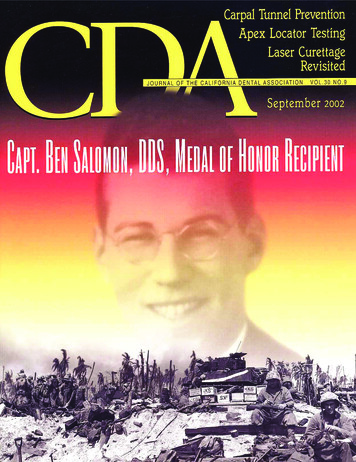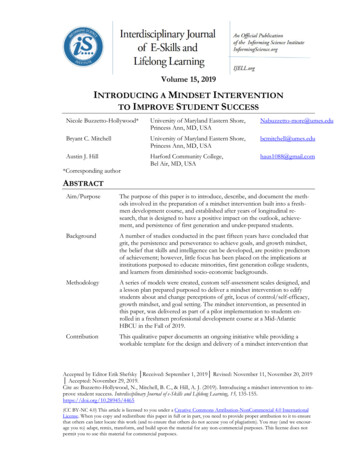
Transcription
Journal643655706CDA JournalVolume 30, Number 9s e p t e m be r 2 0 0 2d e pa rt m e n t sThe Editor/Good AcronymsImpressions/Clowning Around in the Dental OfficeDr. Bob/Placebo Surgeryf e at u r e s665D enti st H er o Finally Awar d e d Co n gre s s i o n a l Me da l o f H o n o rIt took a five-year campaign, but Robert West, DDS, made sure Capt. Ben Salomon, DDS, was finally honored for hisheroism during World War II.Collette Knittel671P r eventi o n o f C u m u lative T rau m a I n ju ry - - Ca rpa l T u n n e l Sy n d ro m eThe REST program offers dentists a way to avoid a common injury.Randy Q. Ligh, DDS681Th e Acc u r acy o f th e N eo s o n o U lt i m a E Z Ape x Lo cato r U s i n g F i l e s o f D i ffe re n tA lloys : A n I n V i tr o Stu dyThis study found that the accuracy of the Neosono-Ultima EZ apex locator in wet conditions exceeded 90 percent.M.H. Nekoofar; K. Sadeghi; E. Sadighi Akha; M. Sadegh Namazikhah, DMD
Editorheadc da j o u r n a l , vo l 3 0 , n º 9Good AcronymsJack F. Conley, DDSAn acronym, by definition, is aword formed from the initialletter of each of the successiveparts of a compound term(or name). Many have beenused in dentistry, including such commonabbreviations such as DDS (doctor ofdental surgery), DA (dental assistant), andRDH (registered dental hygienist), whichrefer to members of the dental team.In our experience, acronyms haveoften been associated with regulations,regulatory bodies, or health caredelivery systems. Terms such as OSHA(Occupational Safety and HealthAdministration), DMFS (Dental MaterialsFact Sheet), PPO (preferred providerorganization), FFS (fee for service) andHMO (health maintenance organization)are among the most frequently utilized.Sometimes these acronyms have anegative connotation to dentists. Thoseapplied to the delivery systems haveadditionally been referred to as “alphabetsoup.”Our present purpose is to focus ona couple of acronyms that without anydoubt have been extremely positivefor dentistry in California, MICRA andTDIC. Let us explain. In a news releasedated mid-June, the American MedicalAssociation released the results of a50-state analysis showing that “medicalliability has reached crisis proportionsin 12 states, with more than 30 othersseeing problem signs.” The AMA saidmedical liability insurance (premium),which insures doctors against malpracticelawsuits, could reach as much as 200,000or more annually for some physicians,such as surgeons or obstetricians. TheAMA president noted that as insurancebecomes unavailable or unaffordable,physicians would either be forced to limittheir services or to leave practice. Therelease further states that several firmshave either failed or have stopped writingmalpractice insurance.Of particular interest is that inmedicine, only 5 percent of malpracticecases are taken to trial. Physicians andhospitals apparently want to avoid thenegative publicity or expense of lawsuitsand trial preparation that they fear wouldoccur if they take cases to trial.That brings us back to dentistry, anddentistry in California to be specific. Arewe likely to be faced with a similar dangerto that faced by medicine? While we needto be extremely careful in assuming whatthe future may hold for fear of settingup a jinx, at the moment, it appearsthat California dentists are in a veryfortunate position for two very importantreasons. We must remember that inthe 1970s and early 1980s Californiadentistry experienced its own crisis ofrising malpractice costs. While we didn’texperience a crisis of the same magnitudeas that currently faced by medicine, itbrought forth some committed visionaryminds to forge some solutions that wecontinue to benefit from today.The first part of our solution wasMICRA (Medical Injury CompensationReform Act of 1975), which placed a caps e p t e m b e r 2 0 0 2 643
editorc da j o u r n a l , vo l 3 0 , n º 9on non-economic damages of 250,000.We have the hard work of our associationto thank for being a major participant,along with TDIC, in the coalition(Californians Allied for Patient Protection-- CAPP), which continues to lobby tomaintain the cap. The California MICRAlaw is currently being discussed by theAMA as a model, in their campaign tourge Congress to develop a Health Act of2002 to resolve the current malpracticecrisis.MICRA’s limit on pain and sufferingawards has kept malpractice premiumcosts down. As a result, it has obviouslyresulted in keeping all health care costsdown, helped to maintain access tocare, places a limit on attorney fees andcontingency fees, and removed the triallawyers financial incentive to take onnonmeritorious cases.In our view however, the bigger storyhere has been The Dentists InsuranceCompany. In the first years after TDIC’sincorporation in 1980, no one couldhave imagined the impact and benefitit would eventually have for its dentistshareholders in California. The earlyyears were difficult, but visionary leadersand supportive policyholders nursedthe company through the difficult years.As the first dentist-owned professionalliability carrier in the country, it helpedeliminate the unfair premium practicesthat CDA members were being subjectedto by commercial carriers at the time.This summer, TDIC announced thatit had retained an A.M.Best rating of“A” for 2002. Best cited the company forremaining “dedicated to its policyholdersthrough claims and risk management.” Inaddition to good company management,unquestionably, the many qualityeducational programs launched by TDICfor the profession and for students hasbeen a major factor in managing risk and6 44 s e p t e m b e r 2 0 0 2reducing liability claims.Not only has the companyprovided a stable insurance productfor policyholders, but it has providedfinancial benefit to policyholders, CDA,and the CDA Foundation, in the form ofdividends and charitable contributions.The most recent TDIC support isextremely impressive and worthy ofmention. Policyholders have received 39 million in dividends since 1989.Policyholder dividends have been declaredin each of the past five years, includingthe sum of 4.9 million this year alone.The company made a recent charitabledonation to the CDA Foundation,bringing its total contribution to thefoundation to almost 1.4 million. Thesefunds assist the foundation in raisingawareness of dental disease, improvingaccess to care, and providing scholarshipsto students seeking dental careers. Thesecontributions to the public and to ourfuture professionals are achievementsof which all members of the CaliforniaDental Association should be extremelyproud. It is a positive accomplishmentthat contributes to the image of theprofession and should not go unnoticed.The next time we engage inconversation about the negatives that wemust endure in our professional world, wemust at the same time remember the twoacronyms that do so much to protect ourliability interests here in California, TDICand MICRA.
ImpressionsheadSpeaker Suggests Clowning Around inthe OfficeBy Collette KnittelIf you’re cruising down the highwayand see a woman driving beside youwearing a red foam clown nose, it may beFall Scientific Session speaker ChristineHolton-Cashen. No, she’s not late for hernext circus appearance; she just believesin making people smile.“People have a need for stress reliefnow more than ever before,” she explained. “It’s impossible to feel stressedout or angry while wearing a clown nose.”An award-winning speaker, HoltonCashen will give two presentations at thefall Session on how dentists can incorporate humor into the workplace andhow it aids overall office productivity andharmony.“It’s amazing how many people are terrified to see the dentist,” she said. “Whena dentist has a good sense of humor,it trickles down. The staff is happy andit creates a fun atmosphere, which thepatients can sense.”Holton-Cashen told of a dentist’soffice that had a poster on an operatorywall of the Three Stooges with Curly andLarry pulling Moe’s tooth. Another dentist would sit down and greet his patientwearing big goofy glasses and say, “Let’shave a look in here. Oops, these are myreading glasses.”Humor comes naturally to HoltonCashen, since she grew up in a selfproclaimed “family of lunatics.” As partof a large Italian family where humor wasmandatory, she was shocked when shemoved out into the world and found howserious most people are.“It scared me,” she confesses.She said she feels that, especially inthe workplace, people have lost theirsense of humor.Although Holton-Cashen is a naturalc da j o u r n a l , vo l 3 0 , n º 9at tickling funny bones, she said that it isa skill anyone can acquire.“It’s possible to be humorous andlight-hearted, even if it’s not in yournature,” she said. “People don’t try itbecause it’s a bit of a risk, but the benefitsare on many levels.”“It doesn’t have to be anything major,”she added. “Humor is not about tellingjokes. You can be childlike without beingchildish. It’s a matter of looking at thingsa different way. It’s keeping your stressgauge on low and your fun gauge onhigh.”In her presentations, Holton-Cashen’sgoal is to get everyone laughing to thepoint of tears. She explained that the endorphin release that accompanies a goodbelly laugh brings on a feeling of calmand relaxation. She also gives 20 humortriggers, or specific things you can do toelicit a smile.These techniques include keeping aSmile File, making a Good Mood Commitment, and going on a Secret Mission.The Smile File can be filled with patients’thank-you cards and notes, and even letters you’ve written to yourself.“I encourage people to send themselves a postcard every time they go onvacation telling about what they’ve doneand closing with Wish you were here.’I call it a mini mental vacation. You caneven feel the sand between your toes.”Her Good Mood Commitment challenges people to commit to saying theyare in a good mood for the first two hoursof every day. She said that you have tomake a conscious effort not to be broughtdown by co-worker’s complaints, and totell everyone who asks that you are in agood mood.“Your brain is like a computer, andit is programmed by the things you say,”she explained. “Even if you are feelinglousy, just fake it. Those two hours will setyour mood for the rest of the day becauseyou’ve created it as such.”The Secret Mission technique worksparticularly well when an office staffmember is stressed out or aggravated by adifficult patient. Holton-Cashen suggestsyou carry a file or something in your handso that you look busy, or like you are ona mission. Take two minutes and walkaround briskly, even though you havenowhere to go.“Shifting from mental to physicalmakes a big difference,” she explained.“Act very serious, like you have somethingimportant on your mind, even though it’llmake you laugh on the inside. I call it atwo-minute stress buster.”At the upcoming Scientific Session inSan Francisco, her first talk, titled “GotHumor? Get Calcium for Your FunnyBone!” will be held on Saturday, Sept.28, from 9:30 a.m. to noon. It focuses onhow humor can enhance brainstorming,increase job satisfaction, create higherproductivity, and improve relationships.Her second talk is from 2 to 4:30 p.m.the same day and is called “Why Can’tEverybody Just Get Along?” During thiscourse, attendees will learn the secrets todefuse anyone in any situation, maintainemotional control, and find the perfectwords for any discussion.Holton-Cashen runs her own business, A Dynamic Speaker, and gives talksall over the United States, as well asCanada, South Africa, and Australia. Sheis a member of the National Speakers Association and holds a bachelor’s degree incommunication and a master’s degree inadult education.More American Children Have HealthCoverageA new Health and Human Servicesreport shows that American children aresignificantly more likely to have healths e p t e m b e r 2 0 0 2 655
impressionsc da j o u r n a l , vo l 3 0 , n º 9insurance today than in 1997, when theState Children’s Health Insurance Program was enacted.In 2001, 10.8 percent of American children did not have health coverage, downfrom 13.9 percent in 1997, according to thenew report from the HHS’s Centers forDisease Control and Prevention. Duringthat period, the number of children without health insurance fell from 9.9 millionto 7.8 million. This 21 percent reductionoccurred as HHS worked to establishprograms in every state to expand healthcoverage to uninsured children.“This report shows that governorshave turned SCHIP into a genuine success story, with healthier children allacross America. Still, we know we mustdo more,” HHS Secretary Tommy G.Thompson said. “We have given governorsmore flexibility to use SCHIP to expandcoverage in their states. We’ve also askedCongress to give states more time to useunspent SCHIP funds so we can build onour successes in getting children healthcoverage.”SCHIP is a state and federal partnership designed to help children withouthealth insurance, many of whom comefrom working families with incomes toohigh to qualify for Medicaid but too low toafford private health insurance. Accordingto state figures, about 4.6 million childrenreceived health coverage through SCHIPat some point in fiscal year 2001. SCHIPplans operate in all 50 states, five territories and the District of Columbia.Researchers Identify First Case of Periodontitis in Marfan’s Syndrome PatientResearchers from the Eastman DentalInstitute at the University College inLondon identified the first case of severeperiodontitis in a person with Marfan’sSyndrome, a rare heredity disorder thatcauses connective tissues to be weakerthan normal. The case report is publishedin the July issue of the Journal of Periodontology.“Reports of oral findings in Marfan’ssyndrome patients have focused mainly656 s e p t e m b e r 2 0 0 2on skeletal abnormalities. This case isnotable since the detected periodontalbreakdown was severe and could be onlypartly explained by known risk factors,such as cigarette smoking and inadequateoral hygiene,” said Maurizio Tonetti,DMD, PhD, professor and chair of theDepartment of Periodontology at the University College London. “It also supportsour hypothesis that a variety of connective tissue disorders may increase susceptibility to periodontal tissue breakdown.”An oral examination determined the41-year-old patient had swollen and receding gums, severe periodontal ligamentattachment loss on all teeth, and bleedinggums at 76 percent of the areas examined. The patient had no family history ofperiodontitis.“It is important to note that this casereport does not show a causal relationship between Marfan’s syndrome andperiodontal diseases,” said KennethBueltmann, DDS, president of the American Academy of Periodontology. “Moreresearch needs to be conducted to determine if there is an association betweenthe diseases.”However, Tonetti recommends thatMarfan patients follow a preventive oralprogram based on professional toothcleaning and daily brushing and flossing,and that they receive regular screeningsby a periodontist.Marfan syndrome is a heritabledisorder of the connective tissue thataffects many organ systems, includingthe skeleton, lungs, eyes, heart, and bloodvessels. The condition affects both menand women of any race or ethnic group.Scientists estimate that as many as 1million people in the United States mayhave a heritable disorder of connectivetissue, according to the National Instituteof Arthritis and Musculoskeletal and SkinDiseases.Sensitivity to Culture Important Part ofProviding CareWith new immigrant groups flockingto the United States each year, it becomesmore challenging and important forhealth care professionals to be sensitiveto cultural and religious traditions whilestill providing optimal care, Julie A. Browwrote in the May/June 2002 issue of theDental Assistant.Dentists and their staffs must worktogether to ensure that patients feel understood and respected, Brow said. One ofthe most common complaints of patientsis that no one listens to them anymore.By listening to patients, dentists can learnvaluable information that can alleviatecultural conflicts that may arise over thecourse of treatment.Sometimes listening is not enough,Brow said, and other tools must be used.In some instances, patients will cite religious reasons for not having a proceduredone, but those reasons may turn out tobe erroneous and show a lack of understanding of their own religious doctrine.Brow said it is important to be respectfuland nonjudgmental when confrontedwith this possibility and for the dentistto ask if he or she might speak with thepatient’s religious leader on the patient’sbehalf.Another key component to providinggood patient care to a culturally diversepopulation is being proactive and learning as much as possible about the culturalheritage, beliefs, and customs of patients.Brow said misunderstanding othercustoms can create a breach of the trustneeded between a patient and dentist foreffective care.Fixing Fillings the Natural WayResearchers at the University of TexasHealth Science Center at San Antoniohave identified specialized protein cytokines that stimulate odontoblasts.Mary MacDougall, PhD, associate deanfor research and professor of pediatricdentistry and H. Ralph Rawls, PhD, professor of biomaterials in the Departmentof Restorative Dentistry, have developeda liquid “carrier” system to deliver thecytokines to the site of a cavity, reportsan article in the June 2002 The Mission,
impressionsc da j o u r n a l , vo l 3 0 , n º 9publication of UTHSC.They noted that the usual filling materials, amalgam or tooth-colored composites, are not perfect solutions; and theliquid carrier system helps preserve thecytokines and stimulates dentin formation.Rawls said tertiary dentin is thetooth’s own natural defense mechanism,and over time a tooth will naturally produce tertiary dentin, which forms a barrier against bacteria leaking into the pulp.“Stimulating this natural repairmechanism is the first step toward beingable to replace part of the tooth with itsown natural material,” Rawls said.“This is the body’s own naturalprocess,” MacDougall said, “We are justenhancing it.”Jigsaw Puzzles A Guide to LifeEverything I needed to know aboutlife, I learned from a jigsaw puzzle, wroteeditor Jeffrey B. Dalin, DDS, in St. LouisDentistry, June/July 2002.nnDon’t force a fit. If something is meantto be, it will come together naturally.nnWhen things aren’t going so well, takea break. Everything will look differentwhen you return.nnBe sure to look at the big picture.Getting hung up on the little piecesonly leads to frustration.nnPerseverance pays off. Every importantpuzzle went together bit by bit, pieceby piece.nnWhen one spot stops working, move toanother. But be sure to come back later.nnThe creator of the puzzle gave you thepicture as a guidebook.nnVariety is the spice of life. It’s thedifferent colors and patterns that makethe puzzle interesting.nnWorking together with friends andfamily makes any task fun.nnEstablish the border first. Boundariesgive a sense of security and order.nnDon’t be afraid to try differentcombinations. Some matches aresurprising.nnTake time to celebrate your successes .Associate Buy-ins a Viable Option for New DentistsAlthough associate buy-ins are more complex than outright practice purchases andsometimes result in the associate not buying into the practice, the associate buy-inremains a viable option for many new dentists, wrote Larry R. Domer, MBA, in the spring2002 issue of New Dentist.Domer defined an associate buy-in as a transition strategy that includes a formalassociateship phase followed by the associate purchasing a portion of the practice. Anassociate buy-in implies that the associate and practice owner will become co-owners ofthe practice.Domer said that an associate buy-in differs from a simple associateship because of theintent of the parties: that the associate dentist eventually becomes a co-owner of the practice.An important advantage of an associate buy-in is
TDIC. Let us explain. In a news release dated mid-June, the American Medical Association released the results of a 50-state analysis showing that “medical liability has reached crisis proportions in 12 states, with more than 30 others seeing problem signs.” The AMA sai











